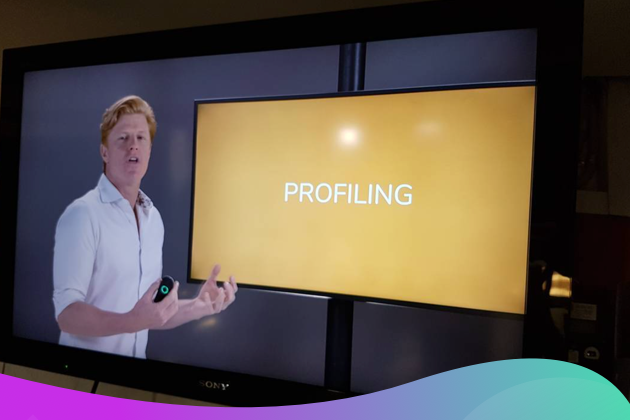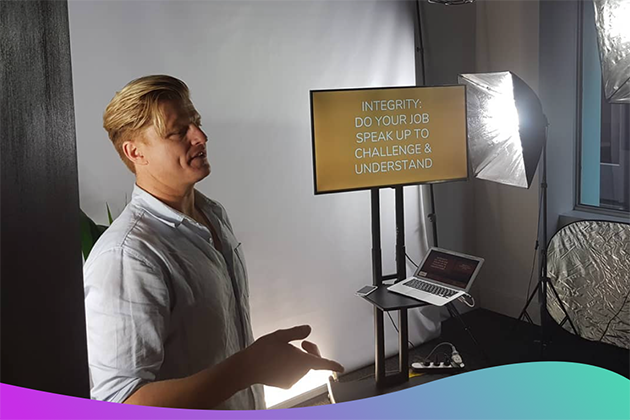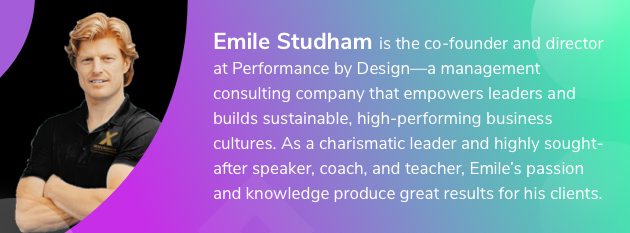Live your Dream: Best Leadership Practices to Manage Adversity and Transition

Your business and team have been through so much over the last year. With many businesses online or adopting a hybrid model, building and leading a high-performing culture with your team is more important than ever. Don’t leave your culture to chance because it will drive your team’s performance, especially under pressure.
There’s no one better to learn culture and leadership from than Emile Studham—the co-founder and director at Performance by Design (PBD), a management consulting company that empowers leaders to build inclusive, healthy, and high-performing business cultures. Emile also has a background in Kinesiology, behavioral sciences, hypnotherapy, and neuro-linguistic programming, and spent 12 years playing semi-professional Aussie Rules football.
Emile’s business journey began with his Toronto-based company, Aussie X, which was featured on season 6 of Dragon’s Den. This company featured an early version of the PBD system under the guidance and mentorship of PBD co-founder Gerald Murphy. The impact empowered the business to grow more than 30% every year and it expanded until it eventually became X Movement Inc.
Emile has a unique perspective, taking lessons as a former athlete and PBD’s work with professional sports teams, and applying them to businesses to create a winning culture and lead successfully. In this Live Your Dream webinar recap, Emile gave business owners like you simple and practical tools for accelerating your team’s performance, including:
- Training and behavioral frameworks for enabling honest conversations that allow your team to make decisions with limited guidance.
- Foundational personality profiling principles for communicating more effectively with your staff members and leveraging skillsets.
- Integral systems and processes necessary to sustain motivation and performance, allowing you, the leader, to work on your highest-impact activities.
It’s time to develop some structure, leadership skills, and work with your team to drive your business and live your dream. But first…
How do you become a leader?
Emile starts off the conversation with the statement “Too many corporate leaders think of culture as something they achieve or get. Culture is behaviors and processes. It’s not a ‘getting thing,’ it’s a doing thing. You do a great culture. You be a great leader.” In striving to be a great leader, Emile says we must start by asking ourselves:
What leadership knowledge and skills must we develop to lead through transition and change, especially through such stressful and uncertain times?
Emile advises not leaving your culture to chance, the stakes are too high, particularly now. Think culture is about social events? That’s certainly part of it, but “what drives your culture is your behavior and your process.”
Emile recommends that you take a look at your leadership, listing these points as important pieces in your “leadership puzzle”:
- Managing your state: You make the best decisions with an alert and relaxed mindset. Make sure you’re showing up in the best way possible. Do you step back if you’re wrong? Call it out? Ask for help? Emile recommends you adopt a morning ritual, so you can start off on the right foot to “own the morning to own the day.”
- Understating self and others: How well do you know yourself and those you lead? As a great leader, you need a high level of self-awareness to manage your own stress and help your teamwork through the stresses they’re dealing with, as well as understand how best to leverage the various skillsets each team member brings to the table.
Personality profile 101: What color are you?
Now it’s time to consider your personality profile. In looking at your characteristics, Emile asks, “What characteristics best describe you?” Emile does this to show that “we see the world not as it is, but as how we are.” Self-perception is key and Emile walks us through the four dominant leadership profiles:
- Cool blue (showing no bias, objective, detached): Loving process and order, these leaders/individuals work well in a team to get things done, the right way. But under pressure, they can become suspicious and indecisive, not liking to be incorrect. They want their teams to be well-prepared, considering all the details, but they don’t like when their routines change or when important issues aren’t taken seriously.
- Earth green (still, tranquil, calming, soothing): They are great team players, bringing harmony to their team. When they get stressed, they can become stubborn and plodding, wanting to avoid any conflict. These leaders want a team to show care for each other, seeking their opinion, without any last-minute surprises or pressure to make quick decisions.
- Sunshine yellow (cheerful, uplifting, spirited): Most of the participants fell into this category; as extroverts, they love relationships and people. In stressful times, they can get excitable and frantic, wanting to avoid rejection. If the team is open and flexible, without boring them with the details, they’ll be happy and successful.
- Fiery red (positive, bold, assertive): These are the doers who are often busy with getting all their tasks done. When things get stressful, these leaders can become over-bearing, aggressive, and take over, not liking the idea of failure. They want their teams to be direct, with a focus on results, and are frustrated by staff waffling or moving too slowly.

What are your dominant characteristics?
While each of us has elements of all four profiles, one category will be dominant. Review the descriptions and rate your colors so you can see your strengths and weaknesses. Understanding which profile you fall into and the order of your colors, will help you navigate your behaviors as you deal with stress. What benefits can you expect once you establish your profile?
- Improving your self-awareness and stress management
- Communicating with influence
- Getting the right people in the right seats
Don’t just profile yourself, profile your team—and your customers. When you make the mistake of thinking that everyone is just like you, it detracts from your success. Get a better understanding of everyone you come into contact with so you can build relationships and “speak to their listening.”
Making the most of your leadership/trust-building skills
Next you need to develop leadership and trust-building skills. For this, Emile wants us to ask ourselves:
How do you want to be recognized as a leader (post-COVID) and what sustainable systems must you implement to build a strong culture that can manage adversity and transition?
Start the process of answering this question by looking at leaders you admire and the traits they possess. Follow Emile’s lead by creating your personal code and focusing on your own values and behaviors. How can you accomplish this?
- Emile recommends that you start by writing down all the characteristics you want to possess as a leader. Write down all the applicable words for two minutes. First, pick your top five words, and then pick the two most powerful words of these five. These are your leadership values.
- “Behavior drives results and your values are lived through your behaviors.” Ask yourself which behaviors you need to eliminate in order to become the leader you want to be. Close your eyes and visualize these behaviors in action, write them down, and be specific. Next, identify the opposite of these behaviours. Identify 2-3 of these desirable behaviors that align with value #1, and 2-3 desirable behaviors that align with value #2. You now have your Personal Leadership Code.
Want to make a change right away to better your leadership and inspire your team? Here are Emile’s quick tips to make immediate changes:
- Use keywords in your language to be authentic and build trust.
- Prioritize these values when you’re under stress, feeling the pressure, and making decisions.
- Remind yourself about your goals and check-in at minimum, weekly, to make sure you’re staying on track.
Focus on real conversations your team
The last piece that Emile tackles is your team. He says, “your job as a leader includes creating an environment for others to perform!” The larger your team gets, the more emphasis you need to place on coaching. Emile uses sports to demonstrate this point:
The “player-coach syndrome”: in sports, the coach cannot just run out onto the field and make a play, although they might want to. The line between “player” and “coach” or “team member” and “business owner” must be clearly defined. Ask yourself this question: as a leader, when you’re under pressure, do you trust or take over?
Learning to focus on building your business and trusting your team is crucial to your success. How do you build a high-performing culture? According to Emile, the secret lies in the “balance between care and support, and challenge and accountability.” He offers these 3 tips to creating an environment where your team can excel:
- See something positive, reward it: respond to great behavior, not just a great result.
- See something negative, challenge it.
- Not sure, ask a question (don’t start with your observation or opinion).
What is real talk?
Decide how you want your team to behave and design a system to recognize, challenge, and create an environment where your team feels safe to engage in “real talk.”
Use Emile’s 4:1 formula, making sure you engage in four positive interactions with your team for every negative one. Real talk is an important step to improvement by showing you want to improve and that you care about your team.

How does the “trust bank” work?
Emile wants us to “keep catching the good, so that when you need to have a touchy conversation, you’ve built up enough trust.” Check in on their behavior, not just results. With trust at the top of the pyramid, and team and talent directly underneath—if you check in on just one of these elements, you will not build a culture of trust. Both are crucial in reaching your goal.
How do you create an environment where others perform at their best?
Emile answers this question with a simple 3-step process:
- Create your team’s culture code by involving your team, including values and behaviors.
- Profile your team so you can understand yourself, understand others, adapt, and connect.
- Implement structures for real talk. Think about things like daily huddles, weekly check-ins, and steady, regular honest conversations with your team.
Why are belonging cues important?
In order to have a team who performs and feels safe and connected to your culture, Emile introduces “belonging cues.” How can you connect in little ways as often as possible to create this type of environment? Here are some suggestions:
- Physical touch (virtual fist bumps)
- Humor and laughter (not as feedback or sarcasm)
- Attentive listening (avoid butting in)
- Small attentive courtesies
- High eye contact (I.e., the video is on during virtual meetings)
Develop a 4-step check-in process
Disconnection leads to loneliness! Provide a safe, trustworthy environment for your team so they can express themselves, perform at their best and contribute to the growth of your company. Get your team involved in a check-in process at your team meetings with Emile’s 4-step process:
- Choose 3 questions you’d like your team to answer (highlight of the week, something you’re looking forward to, your biggest concern, things that make me nervous, and a teammate shoutout).
- Provide time for reflection (send questions out before the meeting so they can think about it).
- Share answers in large or small groups.
- Identify patterns, insights, and potential roadblocks.
Make sure your team knows that their voices are important. When they do, you build a culture where people will come forward with the information you need to manage your business to the best of your ability. This is how you build “the muscle” of real talk! Your job as a leader, especially in these post-COVID days, is to make sure you’ve set yourself and your team up for success.
It’s time for your team to perform at its best
Emile wraps up with a quick recap on how to get your leadership practices to the next level: start with yourself (manage, understand, and create your code) and then focus on your team (create the culture code, profile your team, and implement real talk). It’s so important to use your leadership skills to create a winning culture to navigate through the toughest times in your business.
With stress plaguing the fitness industry, take the time to connect with your team to check in and focus on thriving through adversity. How can you simplify your processes so you can focus on your leadership and culture? Get the tools you need to make managing your business a breeze. With WellnessLiving, you can automate your marketing, go virtual, make your team’s lives easier, and more!
How can WellnessLiving benefit your business and help you live your dream? Book a free, no-commitment demo today to learn more!

Want to learn more? Contact Emile for a 30-minute Zoom call to audit your culture and performance.
Reach Emile at emile@performancebydesign.co to learn more.
Visit Performance by Design here.






